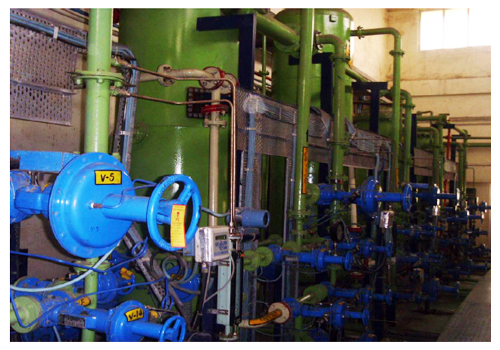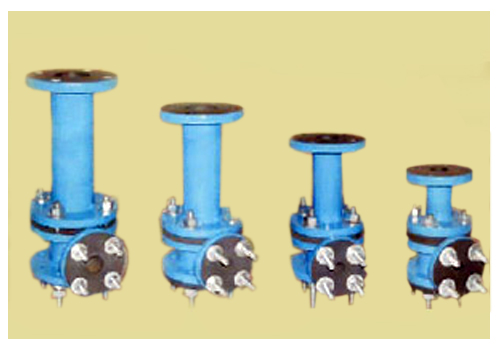Demineralization or Deionisation is the process of removing mineral salts from water by using the ion exchange process. With most natural water sources it is possible to use Demineralisation and produce water of a higher quality than conventional distillation. We manufacture a Wide range of Dematerializing plants for industrial process water applications. They are available in different sizes and materials, manually operated, Semiautomatic or fully Automatic.We are also dong revamping of old plants.
Principle of Operation : A Typical two-bed DM Plant consists of two MS Rubber lined Pressure vessels connected in series along with its internal fittings. The first unit consists of high capacity strongly acidic cation exchange resin, which converts positive ions of salt and replaces them with hydrogen ions to form respective acids, which are absorbed in next vessel by strongly basic anion exchange resin. The water obtained by this process shows conductivity less than 20 µ S / cm at 25 Deg C and total dissolved solids less than 10 ppm.
Further high purity water can be achieved by Mixed Bed Deionisers, which are designed to produce high purity treated water. They can be used as polishing units after two bed DM Plant to obtain high purity water. Mixed Bed Deionisers are single column units, filled with strongly acidic cation and strongly basic anion exchange resins mixed together. There are four distinct stages in the operation of Deionisers
- Service
- Backwashing
- Regeneration
- Rinse/remix

DM Plant. Capacity: 2 X 15 M3/hr Installed at Essar Power Ltd., Gujarat
Backwashing : After the resins are exhausted, the bed is backwashed. Backwashing is carried out by a uniform upward flow of water through the resin bed. The backwash step expands the resin bed releasing any entrapped particulate matter & removes the channeling in the resin column if occurred during the service cycle.
Regeneration : When the ion exchange resins loose all the exchangeable ions, they require regeneration to restore them back to hydrogen or hydroxyl form depending upon whether they are cation or anion resins. To achieve this 4 - 5% concentrated solution of Hydrochloric acid is used for cation resin and a 4% - 5% concentrated solution of caustic soda for anion resin.
Rinse : The final stage of regeneration is to rinse the resins of excess regenerant

DM Plant. Capacity: 2 X 15 M3/hr Installed at Essar Power Ltd., Gujarat

DM Plant. Capacity: 2 X 15 M3/hr Installed at Essar Power Ltd., Gujarat

DM Plant. Capacity: 2 X 15 M3/hr Installed at Essar Power Ltd., Gujarat

DM Plant. Capacity: 2 X 15 M3/hr Installed at Essar Power Ltd., Gujarat
ITEM |
MOC |
SERVICE |
|---|---|---|
| EJECTOR | MS with Ebonite / PP / HDPE lined | For ACID / Caustic Resin / carbon charging |
| Fume Absorbers | PP with FRP Coated | Acid storage and measuring Tanks |
| Acid Proof level Gauges | Polyproelyne | Acid / caustic storage tanks/measuring tanks |
| MSRL PIPES | HARD / Soft rubber lined | For corrosive service |
| HDPE Lined MS Pipes | MS + HDPE | For corrosive service |
| PP lined steel pipes | MS + PP | For corrosive service |
| MSRL and Rubber covered Measuring Tanks | MS with rubber lined and rubber covered | Acid / Caustic |
| Middle collector Headers | Rubber line & Rubber covered Stainless steel | SAC / SBA/MB |
| Laterals | Stainless steel / PVC / PP | SAC / SBA / MB |
| Lateral Strainers | Polyproelyne | SAC / SBA / MB |
| Single Decker & Double Decker Strainers | Polyproelyne | Bottom collecting for SAC / SBA / MB |
| Resin Traps | SS 316 with fine SS wire mesh | SAC / SBA / MB |

